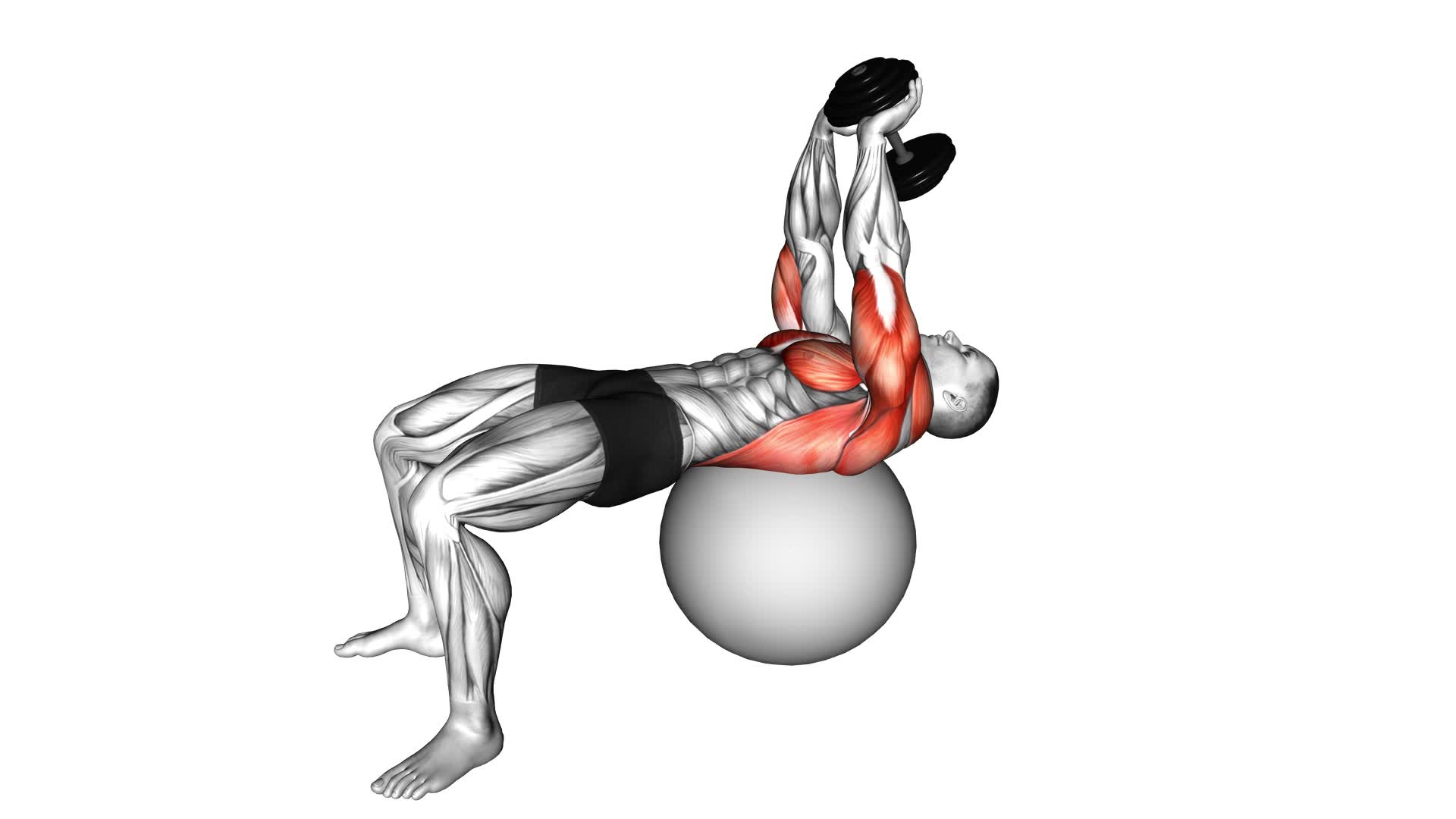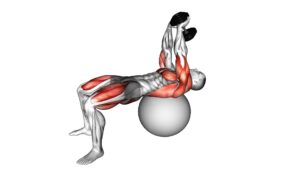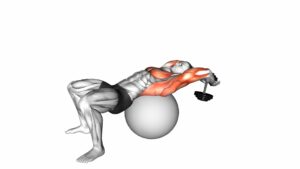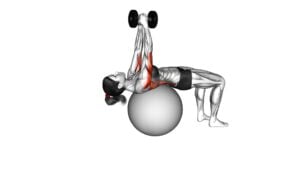Dumbbell Lying Pullover on Exercise Ball – Video Exercise Guide & Tips

Are you looking to level up your upper body workout? Then the dumbbell lying pullover on an exercise ball is just what you need! This exercise targets your chest, back, and core muscles, giving you a full-body burn.
Watch This Exercise Video
With proper form and technique, you can maximize your results and build strength. Grab your dumbbells, hop on the exercise ball, and get ready to feel the burn with this effective and challenging exercise.
Let's dive in and learn how to do it right!
Key Takeaways
- The dumbbell lying pullover targets multiple muscle groups including the chest, back, and core.
- Proper form and technique are essential for maximum effectiveness, including maintaining a stable position on the exercise ball and keeping arms straight throughout the movement.
- Modifications and variations can be made to increase intensity or adapt to different equipment availability, such as increasing the weight of the dumbbell or performing the exercise on a flat bench.
- Incorporating proper breathing techniques and warm-up exercises into the workout routine can enhance performance, prevent injuries, and optimize workout efficiency.
Benefits of the Dumbbell Lying Pullover
You should regularly incorporate the dumbbell lying pullover into your workout routine to maximize the benefits. This exercise is highly effective for muscle activation and can help you achieve your fitness goals. The dumbbell lying pullover primarily targets the muscles in your chest, back, and shoulders. By performing this exercise, you can strengthen and tone these muscles, improving your overall upper body strength.
One of the key benefits of the dumbbell lying pullover is its ability to activate multiple muscle groups simultaneously. During the exercise, your chest and back muscles are engaged as you move the dumbbell from behind your head to over your chest. This movement also engages your shoulder muscles, helping to improve their strength and stability.
Another important aspect of the dumbbell lying pullover is the breathing technique involved. As you lower the dumbbell behind your head, you should inhale deeply, filling your lungs with air. Then, as you lift the dumbbell back up, you should exhale, releasing the air from your lungs. This breathing technique not only helps to improve your oxygen intake but also enhances the effectiveness of the exercise.
Incorporating the dumbbell lying pullover into your workout routine can provide numerous benefits for your upper body. By activating multiple muscle groups and utilizing proper breathing techniques, you can maximize your results and achieve a stronger, more toned physique.
Proper Form and Technique
Maintaining proper form and technique is essential when performing the dumbbell lying pullover on an exercise ball. This exercise targets multiple muscle groups, including the chest, back, and shoulders. To ensure you're performing the dumbbell lying pullover correctly, there are a few common mistakes to avoid.
Firstly, it's important to maintain a stable position on the exercise ball. Make sure your feet are firmly planted on the ground and your core is engaged to prevent any unnecessary movement. This will help to maximize the effectiveness of the exercise and minimize the risk of injury.
Secondly, keep your arms straight throughout the movement. This will ensure that the focus remains on the targeted muscle groups and prevents unnecessary strain on your joints.
Lastly, it's important to control the movement throughout the exercise. Avoid swinging the dumbbell or using momentum to lift the weight. Instead, focus on a slow and controlled movement, emphasizing the stretch and contraction of the targeted muscles.
Equipment Needed for the Exercise
To perform the dumbbell lying pullover on an exercise ball, you'll need the following equipment. First and foremost, you'll need an exercise ball. Also known as a stability ball, this equipment is essential for this exercise as it provides an unstable surface, challenging your core and stability muscles. When choosing an exercise ball, make sure it's the appropriate size for your height.
In addition to the exercise ball, you'll need a dumbbell. The weight of the dumbbell will depend on your fitness level and strength. It's recommended to start with a lighter weight and gradually increase as you become more comfortable with the exercise.
To properly execute the dumbbell lying pullover, lie with your upper back supported on the exercise ball, feet flat on the ground, and knees bent at a 90-degree angle. Hold the dumbbell with both hands, extending your arms directly over your chest.
Having the right equipment is crucial for performing the dumbbell lying pullover on an exercise ball. With the exercise ball providing an unstable surface and the dumbbell challenging your upper body strength, you can effectively target your back, chest, and core muscles. Remember to always consult with a fitness professional or trainer if you're unsure about the appropriate equipment or technique for this exercise.
Modifications and Variations
For added intensity, increase the weight of the dumbbell used in the dumbbell lying pullover on an exercise ball. By using a heavier dumbbell, you can challenge your muscles even more and promote further strength and muscle growth. However, it's important to choose a weight that allows you to maintain proper form throughout the exercise.
Here are some modifications and variations you can try to switch up your dumbbell lying pullover routine:
- Alternative exercises:
- Dumbbell pullover on a bench: If you don't have an exercise ball, you can perform the dumbbell pullover on a flat bench. Lie with your upper back and head supported by the bench and perform the exercise in the same way.
- Cable pullover: Attach a straight bar or rope to a cable machine and perform the pullover motion while standing or kneeling.
Common mistakes to avoid:
- Using too much weight: It's important to choose a weight that you can control throughout the entire range of motion. Using too heavy of a weight can compromise your form and increase the risk of injury.
- Hyperextending your lower back: Keep your lower back flat against the exercise ball or bench to avoid excessive arching. This will help target the intended muscles and prevent strain on your lower back.
Remember to always listen to your body and adjust the exercise to your fitness level and abilities.
Tips for Maximizing Your Workout
Maximize your workout by incorporating proper breathing techniques. Breathing plays a crucial role in optimizing your workout performance and maximizing the benefits of your exercise routine. To make the most out of your workout, it's essential to focus on your breath and ensure that you're breathing correctly throughout your exercises.
Before you start your workout, it's important to warm up properly. Incorporating warm-up exercises into your routine can help prepare your body for the workout ahead. Warm-up exercises can include light cardio activities like jogging or jumping jacks, as well as dynamic stretches to loosen up your muscles.
When it comes to breathing techniques during your workout, it's important to remember to inhale and exhale at the appropriate times. While performing strength training exercises, such as the dumbbell lying pullover on an exercise ball, exhale during the exertion phase and inhale during the relaxation phase. This will help provide your muscles with the necessary oxygen and energy to perform at their best.
Proper breathing also helps maintain stability and support during exercises, reducing the risk of injury. By focusing on your breath, you can engage your core muscles and improve your overall body control and stability.
Incorporating these warm-up exercises and breathing techniques into your workout routine can help you maximize your workout and achieve your fitness goals more effectively. Remember to always listen to your body and adjust your breathing accordingly to ensure a safe and efficient workout session.
Frequently Asked Questions
How Many Reps and Sets Should I Do for the Dumbbell Lying Pullover Exercise?
To progress in the dumbbell lying pullover exercise, it's important to know how many reps and sets to do. Without the context of the exercise, the ideal number of reps and sets can vary depending on your fitness level and goals.
However, a common recommendation is to start with 3 sets of 8-12 reps. Remember to focus on proper form and avoid common mistakes like using excessive weight or arching your back.
Can the Dumbbell Lying Pullover Exercise Help in Improving Posture?
Yes, the dumbbell lying pullover exercise can help improve your posture.
By incorporating this exercise into your full body workout routine, you can strengthen your back, chest, and core muscles, which are all essential for maintaining good posture.
To properly execute the exercise for maximum results, lie on an exercise ball with your feet flat on the ground, hold a dumbbell with both hands, and slowly lower it behind your head while keeping your core engaged.
Is the Dumbbell Lying Pullover Exercise Suitable for Beginners?
The dumbbell lying pullover exercise is effective for targeting the chest and back muscles. It can be a suitable exercise for beginners, as it helps improve posture and build strength.
If you have limited mobility, the dumbbell lying pullover exercise can be modified by using lighter weights or adjusting the range of motion.
Incorporating this exercise into your routine can help you achieve a stronger upper body and better overall fitness.
Can the Dumbbell Lying Pullover Exercise Help in Reducing Back Pain?
The dumbbell lying pullover exercise can be beneficial for reducing back pain.
By incorporating this exercise into your workout routine, you can strengthen your back muscles and improve your posture, which can help alleviate discomfort.
To properly execute the dumbbell lying pullover exercise for maximum results, lie on an exercise ball, hold a dumbbell with both hands, and slowly lower it behind your head while keeping your core engaged.
Remember to consult with a professional trainer for personalized guidance.
Should I Perform the Dumbbell Lying Pullover Exercise Before or After Other Upper Body Exercises?
To maximize the benefits of the dumbbell lying pullover exercise, it's important to consider when to perform it in relation to other upper body exercises.
Before or after? Well, the answer depends on your goals and preferences.
Some people prefer to perform it before other exercises to activate the targeted muscles, while others prefer to do it afterwards as a finisher.
Just remember to maintain proper form throughout the exercise to avoid any risk of injury.
Conclusion
In conclusion, the dumbbell lying pullover is a beneficial exercise that targets various muscles in the upper body. By using proper form and technique, along with the necessary equipment, you can maximize the effectiveness of this exercise.
Additionally, there are modifications and variations available to suit different fitness levels and goals. By following these tips and incorporating the dumbbell lying pullover into your workout routine, you can enhance your strength and overall fitness.

Author
Years ago, the spark of my life’s passion ignited in my mind the moment I stepped into the local gym for the first time. The inaugural bead of perspiration, the initial endeavor, the very first surge of endorphins, and a sense of pride that washed over me post-workout marked the beginning of my deep-seated interest in strength sports, fitness, and sports nutrition. This very curiosity blossomed rapidly into a profound fascination, propelling me to earn a Master’s degree in Physical Education from the Academy of Physical Education in Krakow, followed by a Sports Manager diploma from the Jagiellonian University. My journey of growth led me to gain more specialized qualifications, such as being a certified personal trainer with a focus on sports dietetics, a lifeguard, and an instructor for wellness and corrective gymnastics. Theoretical knowledge paired seamlessly with practical experience, reinforcing my belief that the transformation of individuals under my guidance was also a reflection of my personal growth. This belief holds true even today. Each day, I strive to push the boundaries and explore new realms. These realms gently elevate me to greater heights. The unique combination of passion for my field and the continuous quest for growth fuels my drive to break new ground.







